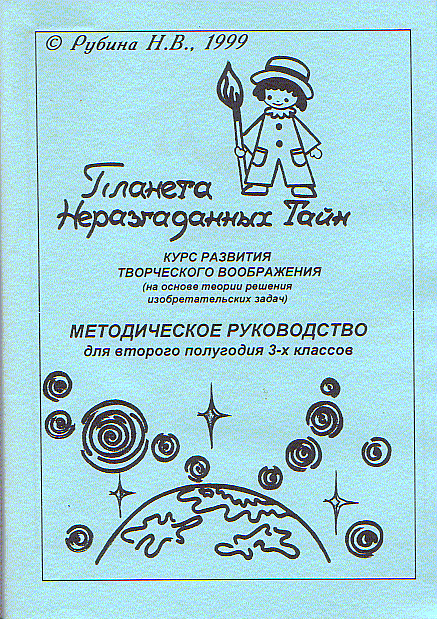Course of Creative Imagination Development (CID) Based on TRIZ, 3rd Grade, 2nd Semester,
Methodical Guide-Book
List of posting in this Home Page:
| Feb. 19, 2002 | 3rd Grade/2nd Semester "Planet of Unsolved Misteries" | Whole volume | Guide-Book | Workbook |
Editor's Note (Feb.
19, 2002):
Please refer to the Editor's Preface (by T. Nakagawa) and the Author's
Introduction (by N. V. Rubina) on the top page of this Course textbook
series. The present posting finishes the whole set of 6 Guide-Books
and 6 Workbooks of the CID Course for Children of 1st to 3rd grade.
It is our pleasure that the whole material of the Course has been posted
in this public Web site in about one year (starting on Jan. 30, 2001),
i.e. much faster than we initially planned. We should appreciate
much responses from our readers.
| Top of this page | Contents | Front Cover | Preface | Symbol marks | Weekly Topic Planning | CID Course Top Page |
Contents
of the CID Course, 3rd Grade, 2nd Semester Course
Top Page:
| Book Title;
Grade/Semester |
Contents | Guide-
Book |
Work-
book |
Posted
date |
| "Planet
of Unsolved Misteries"
3rd Grade,
|
Preface and Weekly Topic Planning | Feb. 19,
2002 |
||
| 1. Modeling with Smart Little People | Feb. 19,
2002 |
|||
| 2. Practice Work on Solving Problems | Feb. 19,
2002 |
|||
| Appendices 1 & 2 | Feb. 19,
2002 |
(C) N.V.Rubina,
I. Dolina, T. Nakagawa, 2002
Planet of Unsolved Misteries
Course
of Creative Imagination Development (CID)
(Based on Theory of Inventive Problem Solving
(TRIZ))
METHODICAL GUIDE-BOOK
Third Grade, Second Semester
Natalia V. Rubina
 |
 |

Planet of Unsolved Misteries
Course
of Creative Imagination Development (CID)
(Based on Theory of Inventive Problem Solving
(TRIZ))
METHODICAL GUIDE-BOOK
Third Grade, Second
Semester

Natalia V. Rubina
Petrozavodsk 1999
English Translation by Irina Dolina, June 17, 2001
Technical Editing by Toru Nakagawa, February 16, 2002
The program of the CID course was elaborated and defined in Petrozavodsk in 1996. Six workbooks with special methodological recommendations (for each semester) were worked out. The program and all the methodological material were probated on the basis of the "TRIZ Laboratory" at the Petrozavodsk School #17.
This pamphlet introduces
the methodological instructions for the first semester of the CID third
grade ("Planet of Unsolved Misteries").
"Planet of Unsolved Misteries". Creative Imagination Development Course for the elementary school (The first semester of the third grade). Methodological instructions.
Reprints and distribution only by author's permission.
 |
(Instead of Preface) |
During the second semester of third grade you
will learn a very interesting method – Modeling with Smart Little People
(MSLP). This method is aimed at overcoming psychological inertia
while solving inventive problems. However, the range of its application
turned to be much wider than its original plan. It turned out that
with the help of Smart Little People many complicated natural phenomena
and many processes taking place in living organisms may be explained in
a way understandable even to the very small children. Besides, the
work according to the method of Smart Little People provides the children
develop for themselves a scientific, research approach towards considering
objects and phenomena surrounding us. The children get a tool which
helps them find answers to the complicated questions: “ How is this designed?”
“How does this work?” “Why does this happen?”.
That is why most of the school time is devoted to
the work on the children’s research projects. It is not easy to organize
such work. A teacher has to have deep knowledge in various fields
of human activities, skills in research work and, of course, considerate
attitude towards children’s creative work.
You have already got experiences in such work:
projects “Perfect Desk”, “Perfect Car”, “Perfect City” from CID Course
for second grade “Fantasy City”. The children’s projects may be connected
with developing history of technical, biological, artistic and other systems;
projecting and modeling the new systems, that implies solving the emerging
problems; conducting card index; writing fantastic stories, tales, stories,
etc. Working on projects is an excellent opportunity to apply all
the knowledge and skills, obtained during the CID course from first
grade to third grade.
So, exciting trips are awaiting you
on the roads of Planet of Unsolved Mysteries. Let’s have luck and
interesting solutions!
The author expresses her deep gratitude to
I. N. Murashkowska, A. A. Nesterenko, M. S. Gafitulin, and M. S. Rubin,
whose works were extremely helpful in elaborating the CID course.
And of course, the assistance of first to third grade students of Petrozavodsk
School No. 17 is invaluable. Thank you, my little magicians.
Your comments and suggestions please send to: 185014, Petrozavodsk, Mail Box 8, OO “TRIZ-Karelia”, Rubina N. V.
For better
perception the following symbols are used in the methodical guide-book:
 |
- problems. For the first grade simple problems demanding answers "yes-no" are used. The major notions of the methods of solving problems are studied in the second and third grades. That is why the most suitable form for solving creative problems is a game "yes-no". The rules of the game are not difficult. After the problem is introduced the kids start to look for the solution by asking questions to which the teacher replies "yes" or "no". The aim of the game is to find a solution by asking as many questions as possible. |
 |
- activities. During these activities it is important that the kids understand how this or that notion may be used for solving the problems, for obtaining new ideas, etc. |
 |
- psychotechnical games. This is a specific part of the lesson. Kids may relax a little and turn to their inner world, the world of a child's fantasy. It goes without saying how important is the atmosphere of trust, friendliness in your small community. |
 |
- speech developing activities. We all know very well how easy to speak with a person who can ask interesting questions. CID classes are structured in a form of a dialogue, therefore actually any task is an exercise on speech developing. Nevertheless, devising their own riddles, proverbs, tales, the kid learns not only to say "full sentences", but develops a need to formulate his idea in such a way that he would be understood and his wits and humor be assessed. Describing various systems, solving unusual problems, the kids enrich their vocabulary all the time. |
 |
- designing a creative product. Don't be confused by an unusual term. "Creative product" is something finished, designed by the kids with the help of methods they study (a riddle, a proverb, a tale, a model of a toy, articles of natural materials and others). |
 |
- tasks-pictures. At the CID classes there are many activities like that because a new creative idea is often embodied in images, especially it refers to the kids with a strong visual representative system. Most of these tasks are unique stuff for a psychologist, for attentive parents, because in this pictures the inner world of a child is reflected as if in a mirror. |
Weekly Topic Planning
(3rd Grade, 2nd Semester)
| Date | Topic | No. of hours | |
|
January February |
1st week
2nd week 3rd week 1st week |
Topic 1. Modeling with Smart Little People | 4 hours |
|
March |
2nd week
3rd week 4th week 1st week |
Topic 2. Practice Work on Problem Solving | 4 hours |
| 2nd week
3rd week |
DKR.
What to check:
|
2 hours |
|
| April | 1st week
2nd week 3rd week |
Review the materials studied in third grade.
Work on projects |
3 hours |
| May |
|
||
[Translation Note (T.Nakagawa,
Feb. 16, 2002): This table of Weekly Topic Planning was modified
slightly to better match with the body of the text.]
| Top of this page | Contents | Front Cover | Preface | Symbol marks | Weekly Topic Planning | CID Course Top Page |
| Home Page | New Information | Introduction to TRIZ | TRIZ References | TRIZ Links |
| TRIZ News & Activities | TRIZ Software Tools | TRIZ Papers and Tech Reports | TRIZ Forum |
Last updated on Feb. 19, 2002. Access point: Editor: nakagawa@utc.osaka-gu.ac.jp